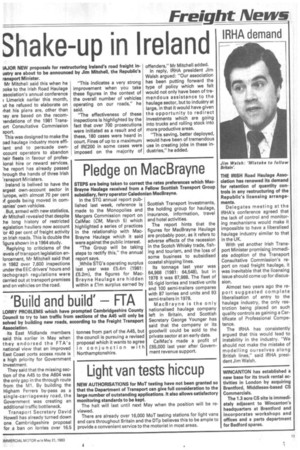Pledge on MacBrayne
Page 15

If you've noticed an error in this article please click here to report it so we can fix it.
STEPS are being taken to correct the rates preferences which MacBrayne Haulage received from a Fellow Scottish Transport Group subsidiary, ferry operator Caledonian MacBrayne.
In the STG annual report published last week, reference is made to the Monopolies and Mergers Commission report on CalMac (CM, March 5) which highlighted a series of practices in the relationship with MacBrayne Haulage which it said were against the public interest.
"The Group will be taking steps to rectify this," the annual report says.
While STG's operating surplus last year was £5.4m (1981: f5.2m), the figures for MacBrayne Haulage are hidden within a Lim surplus earned by Scottish Transport Investments, the holding group for haulage, insurance, information, travel and hotel activities.
The report hints that the figures for MacBrayne Haulage are probably poor, as it refers to adverse effects of the recession in the Scotch Whisky trade, fishing and tourism, and the loss of some business to subsidised coastal shipping lines.
Its tonnage last year was 64,968 (1981: 64,548), but in 1978 it was 87,988. The fleet of 55 rigid lorries and tractive units and 100 semi-trailers compares with 87 lorries and units and 93 semi-trailers in 1978.
MacBrayne is the only nationalised haulage company left in Britain, and Scottish Secretary George Younger has said that the company or its goodwill could be sold to the private sector at an early date.
CalMac's made a profit of £65,000 last year after Government revenue support.
























































































































